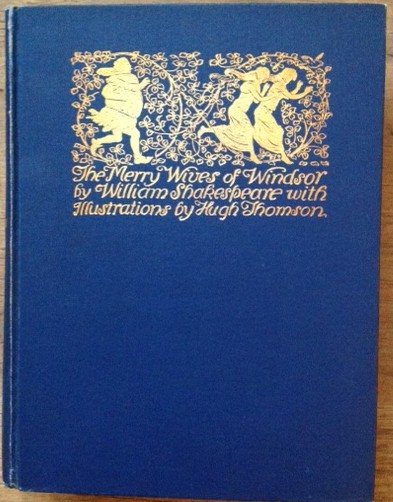Inspiring Older Readers
 posted on 11 Jan 2019
posted on 11 Jan 2019
The Merry Wives of Windsor by William Shakespeare illustrated by Hugh Thomson
I probably don’t need to tell you that the fascination of this book isn’t the Shakespeare play itself but the illustrations to be found in this 1910 edition from William Heinemann. What we have here are 45 colour plates from Northern Irish artists and illustrator, Hugh Thomson which have been tipped-in on a thick gauge paper with each one protected by a sheet of tissue paper. The book is bound in a deep blue cloth and has its title and cover illustration – Falstaff in pursuit of two rather pre-Raphaelite young women - embossed in gold.
So who was Hugh Thomson? Born in 1860 in Coleraine, Thomson was most associated with what has become known as the conservative-minded Regency school of art that consciously rejected the more revolutionary, avant-garde fin-de-siècle art movements that were emerging to challenge the dominant Victorian realist styles. Thomson, along with the likes of Ralph Caldicott and Kate Greenaway continued to work in the realist tradition and put great weight on detailed depictions of life that were drawn directly from the literature they were drawn to illustrate.
Simon Cooke, Assistant Editor for Book Illustration and Design writing on The Victorian Web hits the nail on the head when he describes the so-called Regency school in the following way:
“Literal in approach and sentimental in treatment, this idiom was conservative in the extreme; …..presenting images of classic literary texts that rendered their subjects in terms of eighteenth century costumes, idyllic rural settings, picturesque architecture and the trappings of a fantasy version of pre-industrial England. This was, in other words, a form of escapist nostalgia which asserted the values of an imagined past and was in effect another type of evasion, an approach running in parallel the neo-medievalism of the Pre-Raphaelites and the neo-classicism of painters such as Frederick Leighton and Albert Moore.”
Thomson’s work splits opinion between those that admire his literalness and commitment to researched detail and those who see him as essentially shallow and overly dependent on nostalgia for a fantasy past. To my mind, both sides in this dispute have strong points to make. It is undoubtedly the case that Thomson’s world can be overly whimsical, too ‘clean’ and lacking an innovative, cutting edge or vision. However, to accuse him of being little more than a magazine or greetings card artist is probably too harsh because this under-estimates the quality of the penmanship and his undoubted artistic sensibility. Whilst there are illustrations here that can be dismissed as anodyne, there are others that aren’t far short of the kind of thing that might have come from the pen of more esteemed illustrators such as Arthur Rackham.
There’s also no denying that Thomson was pretty prolific and very popular when it came to illustrating the tried and trusted classics – Shakespeare, Jane Austen, George Eliot and Oliver Goldsmith. Indeed, his popularity was such that he had dedicated exhibitions of his illustrations in Birmingham and in London, where the Leicester Art Galleries that were open in Leicester Square until the mid-1970s exhibited the original watercolours that appear in this copy of The Merry Wives of Windsor.
Like him or not, I don’t think it can be said his work is negligible – he is possibly the most significant representative of an illustrative style that is currently out of favour and socially out of fashion. But what we also know is that fashions change and I’d be willing to bet that Thomson’s work will once again have its champions in the not too distant future.
Terry Potter
January 2019
(Click on any image below to view them in a slide show format)






